How to install a circuit breaker: step-by-step installation instructions
Electrical panels located on the stairwells of apartment buildings are controlled by electricians from the management company. However, you must admit that every home foreman is required to know the purpose of the electrical devices enclosed in a metal box.
We suggest figuring out how to install a circuit breaker if an urgent need arises. We will tell you how the machine is arranged and give recommendations for choosing an electromechanical device.
This knowledge will help to independently replace the device and take measures in an emergency when the machine has worked.
The content of the article:
Why knowledge of electrics is necessary
Information on electrical devices known from school physics lessons is not enough for practical use.
An ordinary consumer is more likely to encounter circuit breakers, since they are the ones that operate in connection with network congestion. It is not enough just to return the lever to its usual position, it is necessary to understand the reasons for the shutdown, otherwise the situation may repeat itself in the near future.

Do I need to be able to independently change the automation? We recommend that you first study the theory, and at the first shutdown - and practice.
The fact is that there is not always the possibility of quick help from professionals: on a day off, electricians relax on a par with the rest. And if the house is located in a country house or in a village, it is better to get acquainted with the electricity network and related devices thoroughly.
Design and purpose of the machine
Despite the name - “automatic”, this type of circuit breaker operates only in one direction - it opens the electric circuit (if the rating is exceeded or the overload associated with the simultaneous inclusion of several powerful electrical appliances). Turning on, that is, closing the circuit, can only be done in the only way - manually.
Unlike a simple single-key switch, an automatic device has a more complex device. Schematically, the classic version (without an electronic unit) is as follows.
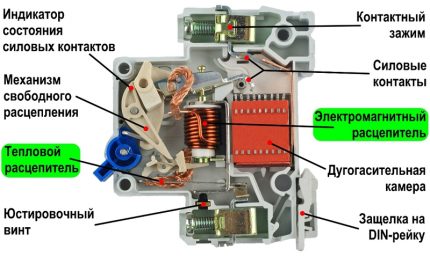
There are several ways to start the trip process:
- manual control - on / off with the help of a small lever;
- current impact short circuit;
- overload - excess of rated current parameters.
In order to prevent a powerful thermal effect from burning the switch, an arc chamber (a set of copper insulated plates) is provided, which cools and breaks the electric arc.
Electromechanical device selection
Given the load parameters and cable characteristics, you can choose a device for installation in an electrical panel. All the necessary information about the electromechanical device is located on its front panel.
Decryption ability circuit breaker marking help make the right choice.
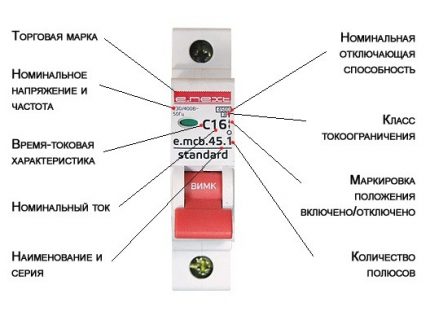
Voltage, frequency and rated current
In the next line, you can find information about two important characteristics - voltage and frequency. The most common “format” is 220 / 400V 50Hz. This means that you can connect both one and three phases at a frequency of 50Hz.
If we take all the structural types, then the correspondence of the poles and voltage will be as follows:
- 1 pole - 220 V, (1 wire - phase);
- 2 pole - 220 V (2 wires - phase / zero);
- 3 pole - 380 V (3 wires - phases);
- 4 pole - 380 V (3 phases / 1 zero).
Rated current limits the use of certain types of cables - and this must be taken into account when choosing automation. Therefore, when buying a switch for an electrical panel, check what types of wires are involved in building the overall circuit.
Preliminary calculation of the circuit breaker rating based on data on the total power of consumers, the availability of inrush current of some electrical appliances, current strength and the estimated demand factor.
In no case do not build on the maximum voltage in the network, otherwise the following may happen.
Suppose the purchase of new household appliances leads to overload and constant knocking out of the machine. You will want to increase its power and replace it with a new one with a higher rated current.
As a result, when several powerful devices are connected to the network, the machine will not work, but the wires will overheat, resulting in a short circuit (insulation will melt, fire will occur).
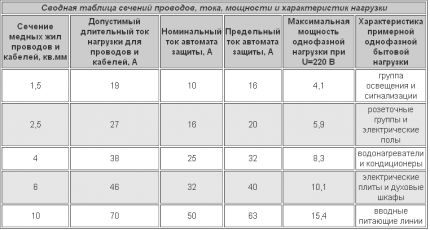
The circuit should be built in such a way that the weakest link is precisely the circuit breaker (and not the wires), which is designed to protect against overload.
Is BTX important
The letter designation of the time-current characteristic is preceded by a digital marking that defines the rated current.
To understand what the essence of BTX is, let's analyze the formula:
k = l / lnwhere
- l - current in the network;
- ln - rated current value;
- k - multiplicity.
The category depends on the multiplicity:
- B - 3
- C - 5
- D - 10
- C - 5
The compliance graph is clearly shown in the figure:
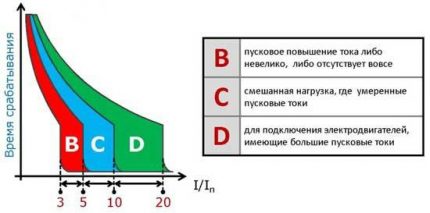
The response speed of the machine depends entirely on the multiplicity: the larger it is, the faster it will turn off. For domestic use, the listed categories are used, but in addition to them, you can find circuit breakers with BTX categories G, K, L, Z.
The circuit breaker B16 at a current of 150 A works instantly, while D16 - only after heating the plate, after a few minutes. The most common category C is used in everyday life and in production, in networks with medium and low starting currents. Category B refers to high-speed, participates in the schemes of old networks.
Keep in mind that the ambient temperature also affects the response speed. The dependence is as follows: the higher the temperature indicator, the lower the current required for the response of the machine.
Experienced electricians at assembly of electrical panels take this correspondence into account and try to leave a little free space inside the shield so that overheating does not occur due to the operation of a large number of devices.
Do not forget about the selectivity rule: of all protective devices embedded in the circuit, the one closest to the overload location should be the first to fire. If the near automatic did not respond, but the next one worked (for example, the driveway), the device parameters were chosen incorrectly.
Pole, PKS and current limit class
The number of poles for modern circuit breakers can vary from 1 to 4, with 1- and 2-pole devices serving single-phase circuits, and 3- and 4-pole ones serving three-phase ones.
PKS is the ultimate (rated) switching (disconnecting) ability. Its indicator indicates the value of the maximum short circuit current (TKZ) at which the machine can still work.
TKZ parameters should not exceed PKS, otherwise the protection guarantee is canceled. If the automatic device has provided protection against TKZ several times, its resource is most likely exhausted and replacement is required.
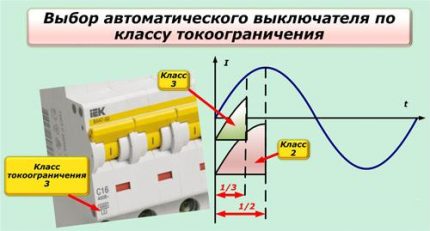
And the last characteristic is the current limiting class. The label may indicate class 1, 2 or 3, in some cases this indicator is not present. If it is not, the device belongs to the 1st class of current limitation. Each class denotes a specific reaction rate of the automaton to the occurrence of TKZ.
Quality and cost depend on the class, as the higher the indicator, the more expensive the device.
The duration of the machines is approximately the following:
- 3rd grade - 3 ms;
- 2nd grade - 5 (6) ms;
- 1 class - about 10 ms.
Most modern switches belong to the 3rd class.
After you select the appropriate circuit breaker, you can begin to install or replace it.
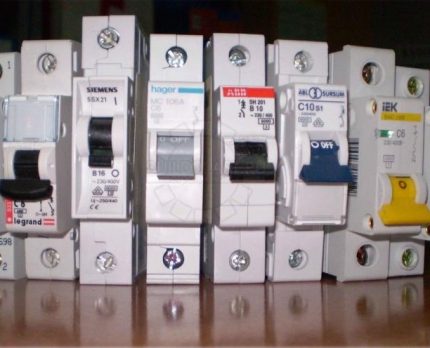
Each element is a module, which occupies the number of places equal to the number of poles (in the figure - samples are unipolar, i.e. 1 place). The size of one “cell” is 1.75 cm, two - 3.5 cm, etc. Additional information on the selection of switches and the characteristics of different models is presented in this article.
Replacing the circuit breaker in the shield
If you open the cover of the electrical panel, you will see that all the modules are fixed on a metal strip called a DIN rail. The width of the plate is 3.5 cm, each module takes 1.75 cm.
To install, you need the following tool:
- pliers;
- screwdrivers - cruciform and straight;
- cable cutting tools, such as wire cutters;
- indicator screwdriver;
- stripping stripper;
- crimper for multi-core cable only.
The first thing that you must always do before any manipulations in the electrical panel is to turn off the power and make sure that no one accidentally connects the power during operation. For safety reasons, use an indicator screwdriver and check for voltage.
Next, take a pre-purchased circuit breaker and attach it to the DIN rail so that it aligns with similar devices. If there is free space at the edges, then it is better to fix the module with special stops - metal brackets on the screws.
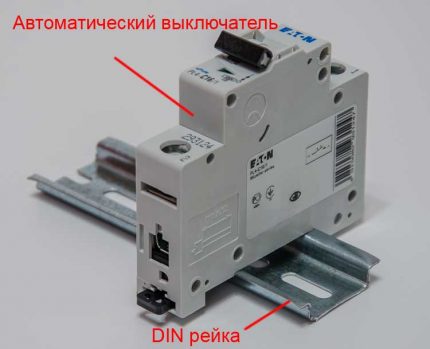
Connecting elements with several poles has differences:
- 2 pole - the left side: top - phase, bottom - phase of the chain; right side: top and bottom - zero;
- 3 pole - the upper parts are the phases in order, the lower parts are the phases of the chain in the corresponding order;
- 4 pole - as 3-pole, but the rightmost module is zero.
As you can see, the main connection principle is that the input is connected to the upper terminals, the output to the lower. Wires are usually routed to the shield. For ease of use, they are grouped with screeds.
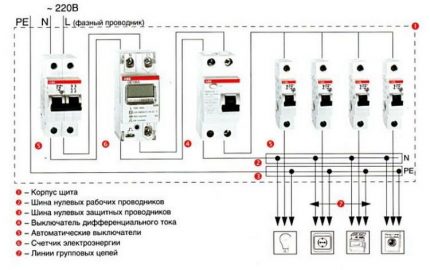
Having stretched the ends of the wires to the corresponding terminals, arrange them freely, without tension, and remove the excess with wire cutters. Construction knife or stripper remove part of the insulation - the length of the bare wire is about 1 cm.
If you use an improvised tool, try not to damage the cable in the transverse direction, so as not to provoke a crease.
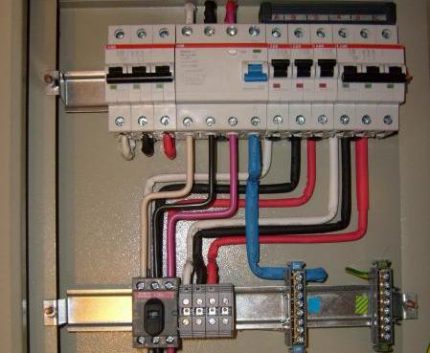
The phase connection can be equipped with a comb - a special bus with the required number of poles. Instead of combs, homemade jumpers from the PV3 wire are also used.
Two wires cannot be placed in one terminal, therefore they must be crimped with the tip of the NShVI.
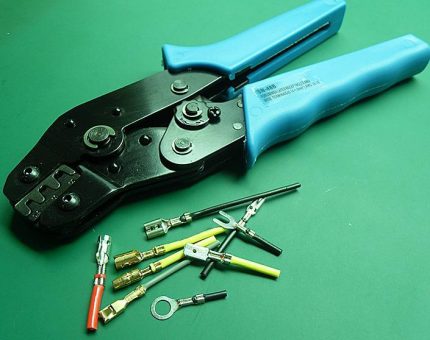
We insert prepared wires into specially designed holes.
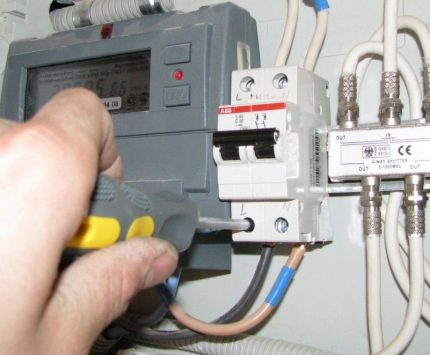
Installation ends with a mandatory system test: apply voltage, connect all devices in the circuit and use an indicator screwdriver to check the presence of voltage in the region of the upper and lower terminals. Instead of a screwdriver, you can use a multimeter.
According to the rules, the device must be marked to indicate its belonging to a specific circuit. A similar marking should be present on the protective cover of the shield.
Instructions for connecting a bipolar machine
Now let's try to figure out connecting a two-pole circuit breaker to the electrical household circuit 220 V. This means that at the input there will be 2 wires - phase and zero.
The wire required for connection has 3 conductors with a cross section of 2.5 mm (VVGngP 3 * 2.5), therefore, the maximum permissible continuous current is 25 A.
Work items
We have chosen a bipolar automatic protection device, which is as follows:
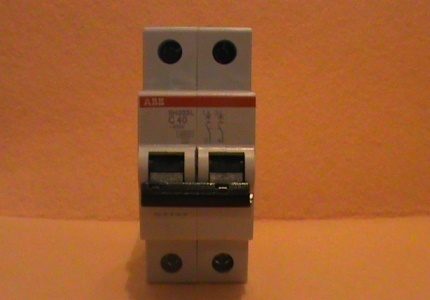
On the surface of the case there is a hint - the connection diagram of the machine.
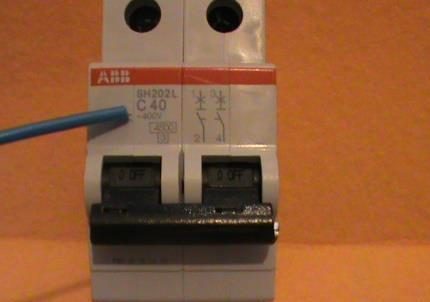
The device is mounted on a metal plate - a DIN rail.
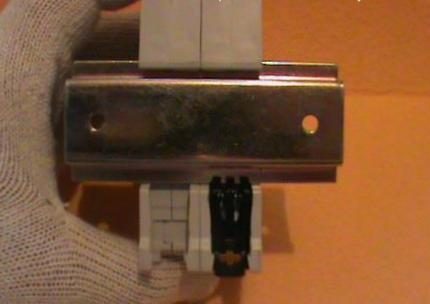
We figured out the components, go to the instructions.
Step-by-step photo tutorial on connecting
We turn off the voltage in the network, check its absence with a multimeter. We prepare wires that have double insulation. Three wires of different colors are hidden under a layer of external protection. The color matching is as follows: black - phase, blue - zero, yellow - earth.
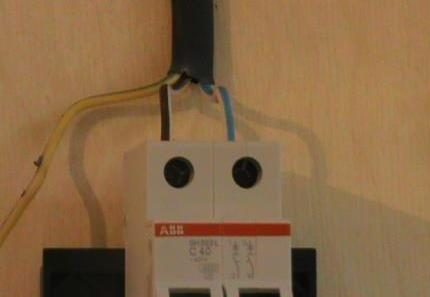
The phase should be on the left and zero on the right. Please note that part of the insulation does not come in contact - when heated, the cable may melt and cause damage to the device. Carefully tighten the screws and proceed to ground.
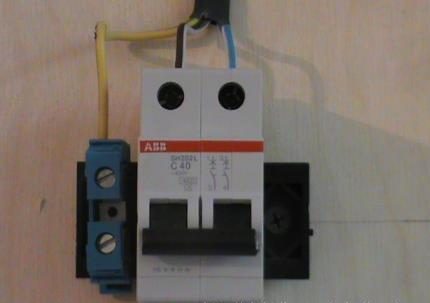
The next step is to connect the outgoing wires that are attached to the lower terminals.
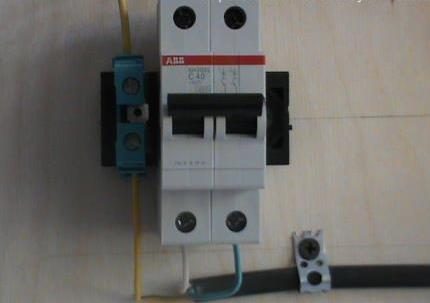
The connection is complete.It remains to apply voltage, put the control lever in the active position and check the operation.
The machine turned off: what to do
Inexperienced user when tripping a circuit breaker and blackout in a hurry to restore the operation of household appliances, so just opens the protective cover and turns on the device. However, this is not quite the right decision, it is better to first find out the reason for the shutdown.
The first thing to do is to check the connected household units and devices, paying attention to the appearance of sockets and plugs, the presence or absence of the smell of burnt plastic. Too hot forks should also alert.
One of the common causes is an increase in energy load. If you have a washing machine and a microwave, and when the vacuum cleaner is turned on, the protection has tripped, which means that an operational overload has occurred. There is one solution - to evenly distribute the load, that is, turn on powerful devices in turn.
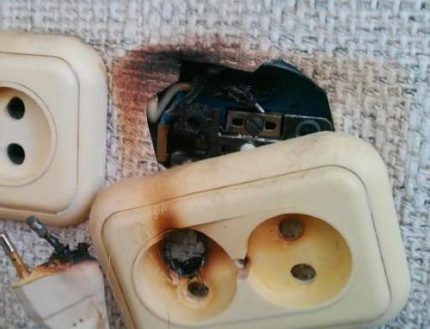
If the number of devices has not increased, the load has not changed, and the shutdown has occurred - perhaps the high temperature is to blame. When the temperature norm in the shield increases, the machine can also work.
And the last reason is the exit from the standing of the circuit breaker itself. After several reactions to a series of increased currents, TKZ, arc extinction, it becomes unusable, which can be determined by external signs. If the terminals are carbonized or the plastic has melted, replace the device.
Conclusions and useful video on the topic
The videos provide information that will help you understand the device and the connection of the circuit breaker.
Part 1. How to choose a circuit breaker - we study the theory:
Part 2. Briefing on the proper selection of the machine:
Step-by-step assembly process for the electrical panel:
Useful advice from a professional:
As you can see, in order to connect a circuit breaker, it is necessary to choose the right device, follow a certain installation procedure and observe safety measures.
If you doubt your own abilities or cannot find the reason for the permanent shutdowns of the protection, be sure to contact a qualified electrician.
Trying to install a circuit breaker yourself? Or maybe they don’t agree with the stated material, or there were questions on the topic? We are waiting for your comments - the communication block is located below.

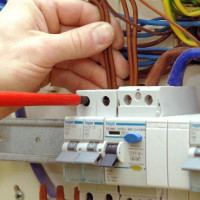 Differential circuit breaker: purpose, types, marking + selection tips
Differential circuit breaker: purpose, types, marking + selection tips 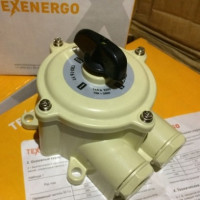 Batch switch: what is it and why is it needed + wiring diagram
Batch switch: what is it and why is it needed + wiring diagram 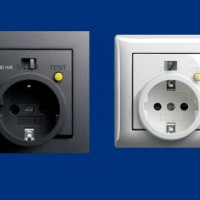 Socket with built-in RCD: device, connection diagram, recommendations for selection and installation
Socket with built-in RCD: device, connection diagram, recommendations for selection and installation 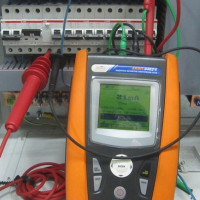 Rules for connecting RCDs to a single-phase network with grounding: briefing on the work
Rules for connecting RCDs to a single-phase network with grounding: briefing on the work 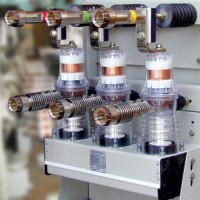 Vacuum switch: device and principle of operation + nuances of choice and connection
Vacuum switch: device and principle of operation + nuances of choice and connection 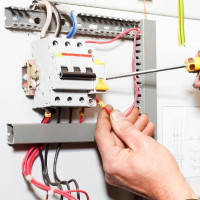 Marking circuit breakers: how to choose the right machine for wiring
Marking circuit breakers: how to choose the right machine for wiring  How much does it cost to connect gas to a private house: the price of organizing gas supply
How much does it cost to connect gas to a private house: the price of organizing gas supply  The best washing machines with dryer: model rating and customer tips
The best washing machines with dryer: model rating and customer tips  What is the color temperature of light and the nuances of choosing the temperature of the lamps to suit your needs
What is the color temperature of light and the nuances of choosing the temperature of the lamps to suit your needs  Replacement of a geyser in an apartment: replacement paperwork + basic norms and requirements
Replacement of a geyser in an apartment: replacement paperwork + basic norms and requirements
A very good instruction for a person unfamiliar with wiring. Therefore, I would like to “disclose the topic”: the observance of selectivity when installing circuit breakers, in more detail about the schemes for their installation in switchboards. And most importantly, about installing several switches, about mounting on a DIN rail - not everyone really knows what it is. And the most important thing - about PE and N tires - it’s shown in the photo, but nothing was said about joining them. But this is important.
Good afternoon, Alexander. In order of questions:
1. Electricity supply of apartments, cottages, as a rule, is carried out according to the simplest schemes that do not affect the issues of selectivity of protection.
2. There is no particular variety of schemes for filling apartment, floor boards, and the most common are considered by the articles presented in the "RCDs and machines" section.
3. The installation of several switches is only more labor intensive.
4. About the DIN rail is mentioned in the article "Assembling the electrical panel with your own hands." In fact, this is a metal profile adapted to the form for mounting electric devices without using fasteners. In the mentioned article there is a photo with a rail on which there are automatic machines, a counter, etc. Attached a screenshot showing the back of the rail - the technology for fixing devices is clearly visible.
5. Conductors of group lines intended for grounding and grounding of household appliances are connected to PE and N buses with individual bolts. The section "Grounding and lightning protection" is dedicated to grounding and grounding on the site.
Good luck
The section is called: “RCDs and automatic machines”, but I did not find information about RCDs, differentiated load switches. And I just need to redo the wiring in the apartment and secure the network to the maximum. Therefore, I would like to see possible examples of device connection diagrams in the shield in the presence of two wires and without an earth wire (apartment in an old building).
Another question on RCDs: I saw RCD-adapters (or adapters) in the outlet on sale. This is when the adapter itself is plugged in, and the plug of the appliance (for example, a washing machine) is already in it. What is the opinion of experts, can this device protect a person in case of contact with a washing machine, which breaks through the insulation?
Good afternoon, Roman. I answer in order of questions:
- in the section "RCDs and machines" there are over 20 information-rich articles - what specific topic were you missing?
- power supply schemes for private houses, apartments are discussed in the section "Installation of wiring" - for example, "How to conduct wiring in the apartment with your own hands from the shield." Several articles discuss the wiring of wooden houses;
- A functioning UZO-socket or UZO included in the socket guarantees safety. I would give preference to an “outlet with an RCD” - a more reliable connection to the network. By the way, the best option is to highlight in the apartment panel a separate line for the washing machine. In the shield, mount the RCD, connect the line to it.